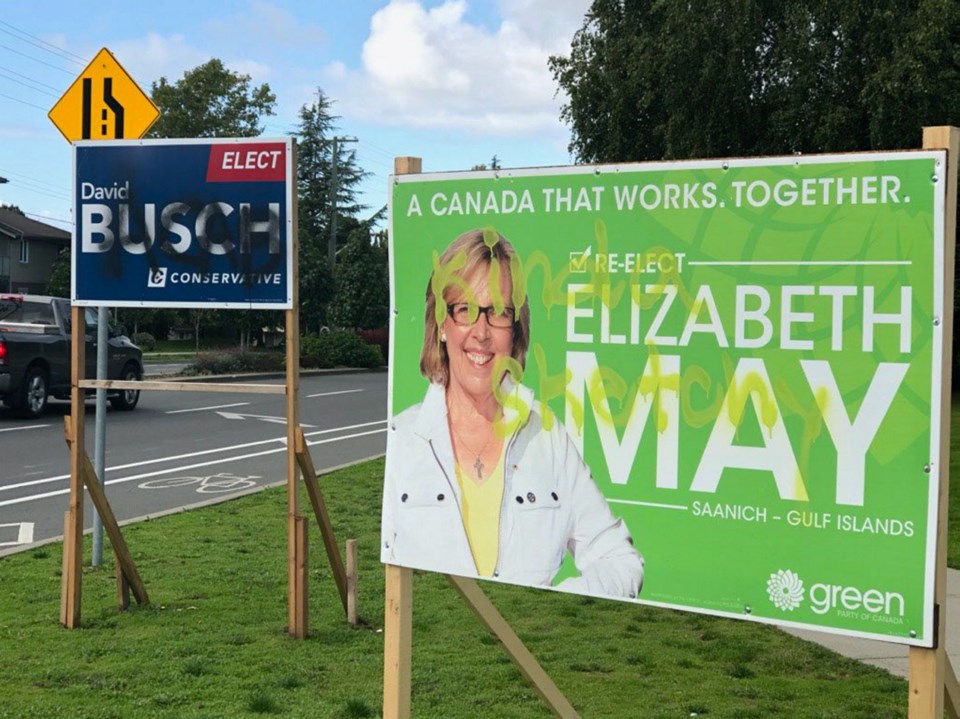Uh oh, here was a problem: Halfway through tattooing my knuckles, I ran out of ink. My left hand spelled H-A-T. So much for my street cred in prison.
“What are you in for, anyway?” my cellmate asked. “Bank robbery? Extortion?”
I shook my head. “No, I destroyed an election billboard.”
Turned out to be a bad decision. Like they say, if you can’t do the time, don’t trash the sign.
The Canada Elections Act does, in fact, allow for a jail sentence of up to six months and a fine of up to $5,000 for anyone caught making off with the roadside signs that spread so perniciously, just like Scotch broom or gonorrhea, during federal campaigns.
Not that the penalties have proven much of a deterrent. Among the recent examples of political vandalism:
• A rash of sign thefts led the Greens to complain to the Nanaimo RCMP on Wednesday. In one case in Ladysmith, two signs were stolen, replaced the next day, then swiped again that night.
• Saanich-Gulf Islands has turned into a Bermuda Triangle for the Liberals, whose signs keep vanishing.
• Likewise, the Conservatives have seen 20 of their large- and medium-sized signs stolen or vandalized in Saanich. Some were spray-painted with ACAB, an acronym for All Cops Are Bastards. Nice.
• A Victoria woman posted photos of a man ripping down her NDP sign and trampling her vegetable garden.
• Alyson Culbert, the People’s Party of Canada candidate in Victoria, said one of her supporters saw a neighbour’s girlfriend cut down a Culbert sign that was zap-strapped to the supporter’s fence.
“Most signs are kicked down or thrown in the bushes within a day or two of being put up,” Culbert said in a news release.
Given that reality, and given the way many regard signs as eyesores, why do candidates keep using them?
Because signs have value even when stolen, even when somebody adds a tinfoil hat to the candidate’s photo (as happened to Elizabeth May in 2015) or paints it in blackface (as just happened to the Liberal in Kelowna).
When someone defaces your signs, the inference is that your opponents are intolerant, jackbooted thugs.
Because even though they’re a terrible way to influence the outcome of an election (really, they add nothing to the discourse), signs work. They build name recognition. Also, by gradually increasing signs’ presence on public land until they are suddenly thicker than the hairlike mass on Donald Trump’s head, a candidate can create the illusion of momentum. (It is, of course, just an illusion. Signs on private property show you have support. Signs on public property show you know a guy with a truck.)
While elections law gives the signs legal protection, municipalities can still regulate their size and location.
For example, the City of Victoria just sent political parties letters listing parks, grassed medians and boulevards where signs are banned for fear they will interfere with trees, plants or underground irrigation systems.
Saanich allows signs beside the road, but not in medians, traffic islands and planting beds, or in parks or on other municipal land. In Oak Bay, residents who let signs stray too far onto public property are placed in stocks.
A few years ago, Comox got so fed up with forests of competing placards blocking sightlines at high-traffic intersections that it banned them from all public land except boulevards in front of private property.
Municipalities can also tell candidates when to remove their signs. Langford says they must be gone within seven days of the end of the campaign. Nanaimo makes candidates post a $200 deposit that doesn’t get returned until the signs come down, which must happen within 30 days of the voting.
The Transportation Ministry is even stickier: if highway-side signs aren’t removed on the first working day after the election, road-maintenance staff can take them down and bill the owner.
The ministry has other rules, too. It generally allows signs on highway rights-of-way during campaigns, as long as they’re not closer to the road than other signs and aren’t a traffic hazard. No election ads on bridges or overpasses, though.
Ditto for certain stretches of highway, such as the Nanaimo bypass and the inland route between Parksville and Campbell River.
In any case, the signs will be gone soon enough. Real political problems will remain.



